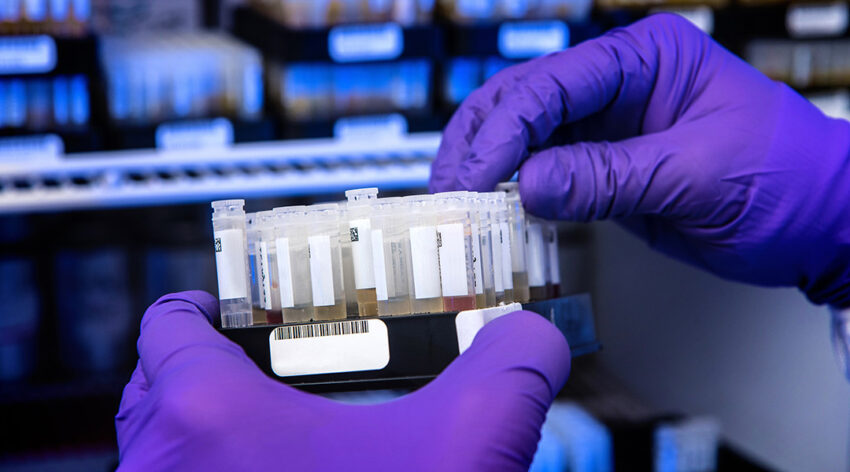Three potent antibodies against SARS-CoV-2 identified in healthy individuals decades ago raises interesting questions about their origins and evolution.
Image credit: CDC on Unsplash
As cases in COVID-19 spike around the world, scientists continue to develop an array of strategies to contain infection and minimize severe outcomes of disease. These include, vaccines, public health measures, as well as antiviral and antibody therapies.
Monoclonal antibody therapies have seen positive results in clinical settings when delivered during early stages of infection. “Like antidotes to toxins, antibodies recognize and neutralize (or destroy) the viral particle by binding to exposed sites of vulnerability on the virus, such as the [SARS-CoV-2] spike protein,” explained Ian Wilson, Hansen Professor of Structural Biology at the Scripps Institute in California.
In a study published in Advanced Science, Wilson and collaborators, Richard Lerner and Guang Yang, sought to identify new human antibodies that might make suitable candidates for treating COVID-19.
Monoclonal antibody therapies have been previously used to treat other infectious diseases such as SARS, MERS, and Ebola, as well as some cancers and autoimmune disorders. “Antibody therapy aims to use the most effective antibody molecules generated either in the immune response (e.g., to SARS-CoV-2) or by other in vitro methods to effectively treat patients with the same infection,” said Yang, professor at the Shanghai Institute for Advanced Immunochemical Studies.
Though experts are quick to point out that they are not a replacement for vaccines, for individuals with a high risk of complications, antibody therapies to treat COVID-19 have seen success and are of particular interest to combat the current pandemic.
However, identifying antibodies that will be effective against a specific pathogen can be challenging. Many antibody therapies also work best as cocktails, in which each antibody targets a different part of the pathogen.
Combinatorial libraries speed up the search
Our bodies’ ability to generate potent antibodies to protect from infection is the result of a long evolutionary process. A historical approach to identifying antibodies has been to collect them from survivors of infection.
But researchers have been able to mimic the evolutionary process using what is known as a combinatorial library. This is a large collection of small molecules, proteins, or, in this case, antibodies, which can be quickly searched to identify the best candidate for treatment.
There are several strategies to make these libraries, but the one in the current study was created by extracting the “B cell or antibody repertoire”, which includes sequencing genetic material from memory cells collected from a set of individuals. This is in essence a record of all of the antibodies that an individual has ever made — a “fossil record” of an individual’s antibody response in a test tube, say the researchers.
“Since the invention of combinatorial antibody library approach, it has been possible to establish an in vitro synthetic immune system to select antibodies that bind to targets of interest from these large human libraries,” explained Lerner, professor of immunochemistry at Scripps. “They leverage the power of large antibody numbers and prior evolution.”
“Under a pandemic situation, the synthetic immune system has an advantage in terms of speed and coverage,” added Wilson.
SARS-CoV-2 antibodies found in 20-year-old library
The team scoured a library established in 1999, and identified three potent SARS-CoV-2 antibodies: S-E6, S-B8, and S-D4.
These antibodies are highly potent and selective for binding to SARS-CoV-2, containing somatic mutations — mutations passed on through somatic cells (any cell in the body except sperm or eggs) and brought about by changes in an organism’s environment — that are key to viral recognition.
This is in sharp contrast to the antibodies isolated from COVID-19 convalescent patients, wrote the researchers. S-E6, S-B8, and S-D4 exhibit new modes of binding to the receptor binding domain of the SARS-CoV-2 spike protein, which could help in the design of more effective vaccines and antibody therapeutics.
“While the library is so large, it is to be expected that antibodies will be found that bind to a target of interest such as SARS-CoV-2,” said Yang. “Finding highly potent neutralizing antibodies from this library of ‘healthy’ donors [years] before the COVID-19 pandemic could indicate prior exposure of [one or more] donor to a related coronavirus or to an antigenic protein that resembles the SARS-CoV-2 receptor binding domain.”
This raises some interesting questions with regards to the origins and evolution of these antibodies. In addition to providing blueprints for new COVID-19 vaccines, the authors expect this approach will be used as a general defense strategy against future pandemics.
Reference: Min Qiang, et al., Neutralizing Antibodies to SARS-CoV-2 Selected from a Human Antibody Library Constructed Decades Ago, Advanced Science (2021). DOI: 10.1002/advs.202102181

